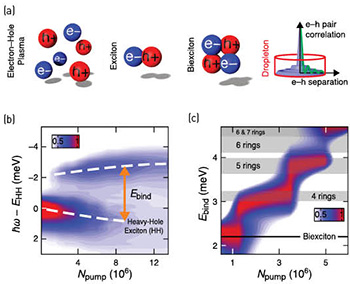 (a) Hierarchy of quasiparticles in gallium-arsenide quantum wells. The dropleton is represented by its two-particle electron-hole correlation function. The red shell indicates the dropleton-plasma boundary. (b) Probe absorption for a range of pump photon number. (c) Differential probe absorption between quantum-optical states chosen to isolate the effect of three-and-greater–photon correlations. Gray bars show theoretical dropleton binding energies.4
(a) Hierarchy of quasiparticles in gallium-arsenide quantum wells. The dropleton is represented by its two-particle electron-hole correlation function. The red shell indicates the dropleton-plasma boundary. (b) Probe absorption for a range of pump photon number. (c) Differential probe absorption between quantum-optical states chosen to isolate the effect of three-and-greater–photon correlations. Gray bars show theoretical dropleton binding energies.4
Quantum-optical spectroscopy is a new tool well suited for studying quasiparticles.1 In semiconductors, these include excitons and biexcitons, as well as higher-order electron-hole clusters. It is virtually impossible to separate the individual resonances of nearly degenerate quasiparticles when limited to traditional optical spectroscopic techniques. However, quantum-optical spectroscopy takes advantage of the prediction that multi-photon correlations in the optical field will excite equivalent electron-hole correlations, i.e., clusters in the semiconductor. Understanding quasiparticles and their interactions has led to increasingly accurate microscopic models of semiconductor systems, benefitting both fundamental science and semiconductor technology.2
We realize quantum-optical spectroscopy by measuring transient-absorption spectra of gallium arsenide quantum wells at 6 K with high precision while scanning a wide range of pump-pulse amplitudes with a mode-locked Ti:sapphire laser. This way, we generate the needed set of system responses over a large region in the phase space of coherent states. Recently, we developed a method that robustly projects the quantum-optical response of a many-body system from a set of measured coherent-state responses.3 The exciton resonance shows the well-known blue shift that corresponds to a gradual decrease of the exciton binding energy. Simultaneously, however, we note a totally unexpected increase in the binding energy of the lower-energy state.
When the absorption is projected into the quantum-optical response resulting from excitation by three-and-greater–photon correlations, new quantized levels emerge with increasing pump photon number. To explain the progression in binding energy, we analyzed an extensive set of many-body configurations and found that the quantized steps can only be explained by a liquid-like state consisting of four-to-seven electron-hole pairs within a microscopic correlation bubble. The quantized energetics, liquid characteristics and small size are unique to a new quasiparticle that we call a dropleton.4 Our dropleton discovery demonstrates the capabilities of quantum-optical spectroscopy; this methodology has already been applied to identify a new quantum memory effect in quantum dot microring emission.5
Researchers
A.E. Almand-Hunter and S.T. Cundiff, JILA, joint institute of the University of Colorado and NIST, Boulder, Colo., USA
H. Li, JILA and Florida International University, Miami, Fla., USA
M. Mootz, S.W. Koch and M. Kira, Philipps-University Marburg, Germany
References
1. M. Kira and S.W. Koch. Phys. Rev. A 73, 013813 (2006).
2. M. Kira and S.W. Koch. Semiconductor Quantum Optics, Cambridge University Press (2011).
3. M. Kira et al. Nat. Phys. 7, 799 (2011).
4. A.E. Almand-Hunter et al. Nature 506, 471 (2014).
5. C. Berger et al. Phys. Rev. Lett. 113, 093902 (2014).
